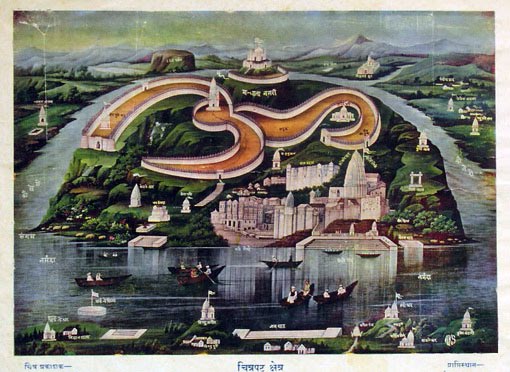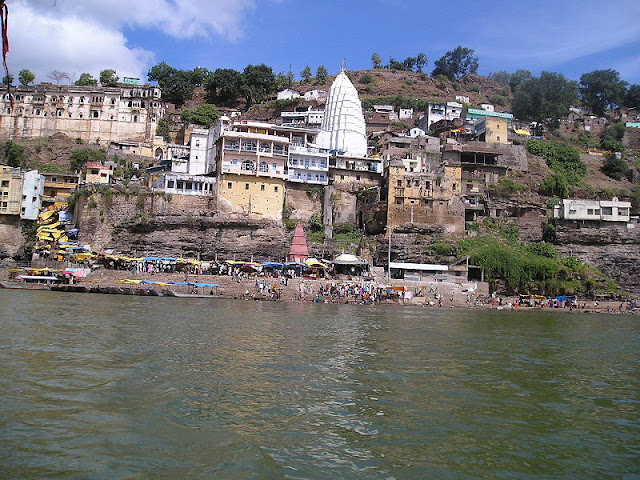There are two main temples at Omkareshwar, one on the mainland and one on the island. The island temple is credited to Mandhata, an ancestor of Rama, who installed the lingam and built the temple. While most consider this one to be the Jyotirling, the place abounds in myth and legend. According to one, this lingam is believed to have split into two and installed itself on the other bank too. According to others, it is the temple of Mamleshwar (also called Amaleshwar or Amareshwar) on the mainland which is older and the real Jyotirling.
Mamleshwar the Jyotirling:
While the island temple has received much attention in the past and has been renovated recently, the Mamleshwar temple certainly looks much older and more beautiful too. The Mamleshwar temple is also more endearing thanks to the absence of the pandas (priests) who are the most prominent feature of the Omkar Mandhata temple on the island. We visited the Mamleshwar temple at night before the final aarti was performed, and had to literally hunt out a priest to perform abhishek to the lord, and the one we finally found was so thrilled by all the items we had brought for the puja that he happily did the elaborate puja with a smile on his face and asked for money only when we were done.Omkar Mandhata:
For a long time, the only way to approach the island was by boat. Now, there are two bridges, one connecting the boat landing area to the Omkar Mandhata temple, the other connecting the two temples — Omkareshwar and Mamleshwar. No vehicles are allowed on the island, so both are only foot bridges. The Narmada which once flowed fast and furious along this stretch is now a tame river, thanks to a dam mired in controversy, of which one gets a wonderful view from the bridge.
The entire island is a hilly area, and it is these hills which give it the shape of the Om. Just a few steps take us to the temple, which is visible from quite a distance.
 |
| Chitrapat Kshetra |
 |
| Omkareshwar |
Omkareshwar Parikrama:
While it is for the temples that most pilgrims visit Omkareshwar, the most interesting thing about the island is the island itself. With its unique shape, the island itself has been venerated, and over centuries, scores of temples have been built on it. The ancients not just built the temples, but also made a path so that one could visit all the temples while circumambulating the entire island. This is called the Omkareshwar Parikrama, and has been recently revived by MP Tourism.
There are many places of interest along the path. The first is the sangam or confluence of the two tributaries of the Narmada. This is, for a change, clean and perfect for a bath. The clear water with rounded pebbles forming the river bed invites us to sink our feet into it and enjoy a relaxed dip, while the more devout pilgrims (few, at the best of times, since it is almost an hour’s walk from the bridge) offer prayers.
 |
| Temple in India |
Then there is the Gori Somnath Mandir, an ancient temple where the lingam is a huge one, jet black in colour. Legend tells us that this lingam was once pure white, and that one could see his past life just by standing in front of it. Then came Aurangzeb, and as soon as he appeared in front of the lingam, it turned black! This is one of the few temples in the area still intact to a large extent. Though many of the beautiful sculptures have fallen down, it still stands tall and proud among the ruins of others which have not been as fortunate!
As we climb down the final steps which lead us to the end of the Parikrama, our aching legs yearn for a rest, but we feel fresh inside, and can’t help thinking that we arrived at Omkareshwar to see one of the Jyotirlings, and were appalled with the rampant commercialisation, but returned with so much more, an inner peace that comes from a truly spiritual experience!
How to reach
Omkareshwar is situated about 65 kms from Indore and 256 kms from Bhopal. The road from Indore takes us through the mighty Satpura ranges, and winds its way along the Ghats before opening up into a plain covered with cotton fields and irrigated by the Narmada. The journey from Indore to Ujjain takes a little more than an hour by car and about one-and-a-half hours by bus.
There are plenty of buses available on this route, both, those run by the MPRTDC as well as private ones. They can certainly not be classified as luxury, but they are comfortable and adequate for the short journey. A car hire for the one way trip costs about Rs 1200.
 |
| Direction to Omkareshwar |
There are plenty of buses available on this route, both, those run by the MPRTDC as well as private ones. They can certainly not be classified as luxury, but they are comfortable and adequate for the short journey. A car hire for the one way trip costs about Rs 1200.







